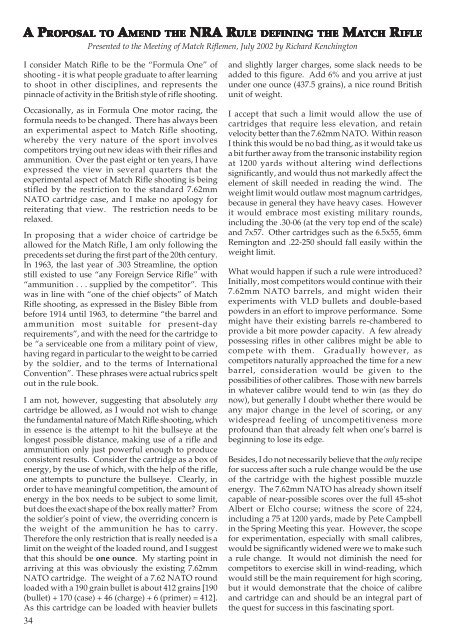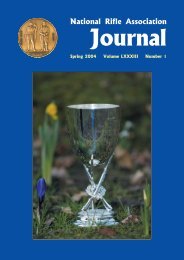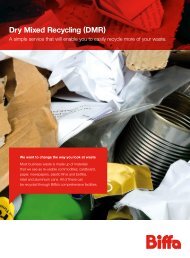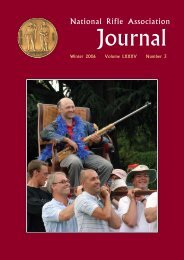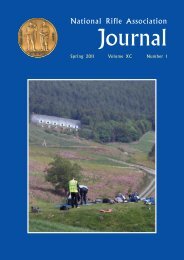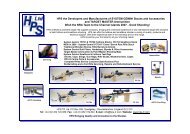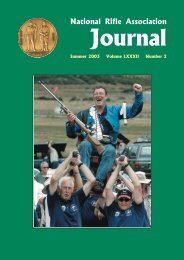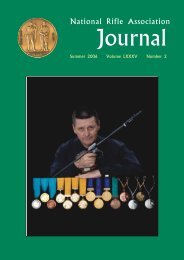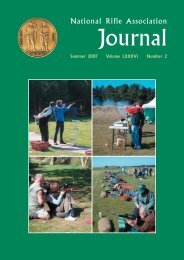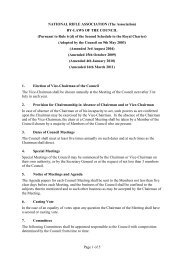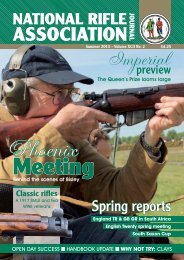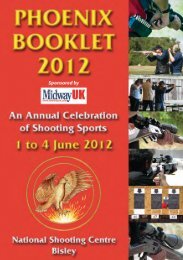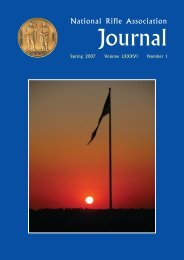Winter 2002 - National Rifle Association
Winter 2002 - National Rifle Association
Winter 2002 - National Rifle Association
- No tags were found...
Create successful ePaper yourself
Turn your PDF publications into a flip-book with our unique Google optimized e-Paper software.
A PNRA RA PROPOSALTO AMENDTHE NRA RULEDEFINING THE MATCHRIFLEPresented to the Meeting of Match <strong>Rifle</strong>men, July <strong>2002</strong> by Richard KenchingtonI consider Match <strong>Rifle</strong> to be the “Formula One” ofshooting - it is what people graduate to after learningto shoot in other disciplines, and represents thepinnacle of activity in the British style of rifle shooting.Occasionally, as in Formula One motor racing, theformula needs to be changed. There has always beenan experimental aspect to Match <strong>Rifle</strong> shooting,whereby the very nature of the sport involvescompetitors trying out new ideas with their rifles andammunition. Over the past eight or ten years, I haveexpressed the view in several quarters that theexperimental aspect of Match <strong>Rifle</strong> shooting is beingstifled by the restriction to the standard 7.62mmNATO cartridge case, and I make no apology forreiterating that view. The restriction needs to berelaxed.In proposing that a wider choice of cartridge beallowed for the Match <strong>Rifle</strong>, I am only following theprecedents set during the first part of the 20th century.In 1963, the last year of .303 Streamline, the optionstill existed to use “any Foreign Service <strong>Rifle</strong>” with“ammunition . . . supplied by the competitor”. Thiswas in line with “one of the chief objects” of Match<strong>Rifle</strong> shooting, as expressed in the Bisley Bible frombefore 1914 until 1963, to determine “the barrel andammunition most suitable for present-dayrequirements”, and with the need for the cartridge tobe “a serviceable one from a military point of view,having regard in particular to the weight to be carriedby the soldier, and to the terms of InternationalConvention”. These phrases were actual rubrics speltout in the rule book.I am not, however, suggesting that absolutely anycartridge be allowed, as I would not wish to changethe fundamental nature of Match <strong>Rifle</strong> shooting, whichin essence is the attempt to hit the bullseye at thelongest possible distance, making use of a rifle andammunition only just powerful enough to produceconsistent results. Consider the cartridge as a box ofenergy, by the use of which, with the help of the rifle,one attempts to puncture the bullseye. Clearly, inorder to have meaningful competition, the amount ofenergy in the box needs to be subject to some limit,but does the exact shape of the box really matter? Fromthe soldier’s point of view, the overriding concern isthe weight of the ammunition he has to carry.Therefore the only restriction that is really needed is alimit on the weight of the loaded round, and I suggestthat this should be one ounce. My starting point inarriving at this was obviously the existing 7.62mmNATO cartridge. The weight of a 7.62 NATO roundloaded with a 190 grain bullet is about 412 grains [190(bullet) + 170 (case) + 46 (charge) + 6 (primer) = 412].As this cartridge can be loaded with heavier bullets34and slightly larger charges, some slack needs to beadded to this figure. Add 6% and you arrive at justunder one ounce (437.5 grains), a nice round Britishunit of weight.I accept that such a limit would allow the use ofcartridges that require less elevation, and retainvelocity better than the 7.62mm NATO. Within reasonI think this would be no bad thing, as it would take usa bit further away from the transonic instability regionat 1200 yards without altering wind deflectionssignificantly, and would thus not markedly affect theelement of skill needed in reading the wind. Theweight limit would outlaw most magnum cartridges,because in general they have heavy cases. Howeverit would embrace most existing military rounds,including the .30-06 (at the very top end of the scale)and 7x57. Other cartridges such as the 6.5x55, 6mmRemington and .22-250 should fall easily within theweight limit.What would happen if such a rule were introduced?Initially, most competitors would continue with their7.62mm NATO barrels, and might widen theirexperiments with VLD bullets and double-basedpowders in an effort to improve performance. Somemight have their existing barrels re-chambered toprovide a bit more powder capacity. A few alreadypossessing rifles in other calibres might be able tocompete with them. Gradually however, ascompetitors naturally approached the time for a newbarrel, consideration would be given to thepossibilities of other calibres. Those with new barrelsin whatever calibre would tend to win (as they donow), but generally I doubt whether there would beany major change in the level of scoring, or anywidespread feeling of uncompetitiveness moreprofound than that already felt when one’s barrel isbeginning to lose its edge.Besides, I do not necessarily believe that the only recipefor success after such a rule change would be the useof the cartridge with the highest possible muzzleenergy. The 7.62mm NATO has already shown itselfcapable of near-possible scores over the full 45-shotAlbert or Elcho course; witness the score of 224,including a 75 at 1200 yards, made by Pete Campbellin the Spring Meeting this year. However, the scopefor experimentation, especially with small calibres,would be significantly widened were we to make sucha rule change. It would not diminish the need forcompetitors to exercise skill in wind-reading, whichwould still be the main requirement for high scoring,but it would demonstrate that the choice of calibreand cartridge can and should be an integral part ofthe quest for success in this fascinating sport.


